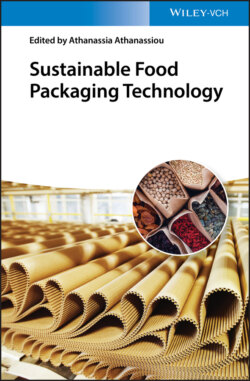Читать книгу Sustainable Food Packaging Technology - Группа авторов - Страница 17
1.3.2 Polyhydroxyalkanoates
ОглавлениеPolyhydroxyalkanoates (PHAs) currently represent one of the most important alternatives to fossil derived polymers in the frame of the Circular Economy [33], showing the highest potential to replace polyolefins in packaging applications due to their biocompatibility and physical properties [34]. PHAs are a family of biopolyesters synthesized by a wide range of microorganisms as carbon storage material. Although they have suitable characteristics such as biodegradability, thermoplasticity, and similar mechanical strength and water resistance to other polymers such as PP and PS [35], their production is expensive due to the high costs of the fermentation and downstream processes. The use of industrial by‐products and waste or mixed microbial cultures (MMCs) represents a viable option to reduce the production costs of PHAs [36].
Among PHAs, the most widely studied and first bacterial member of this family identified was poly(3‐hydroxybutyrate) (PHB). This isotactic homopolyester is biodegradable not only in composting conditions but also in other environments such as marine water and it presents similar thermal and mechanical properties with some petrochemical polymers. However, its use is limited due to its poor impact‐strength resistance and a narrow processing temperature window [37]. To improve these shortcomings, its copolymers such as poly(3‐hydroxybutyrate‐co‐3‐hydroxyvalerate) (PHBV) and poly(3‐hydroxybutyrate‐co‐4‐hydroxybutyrate) [P(3HB‐co‐4HB)] have been explored. Particularly, PHBV is a good candidate since it has a much lower crystallinity and melting temperature, decreased stiffness and brittleness, and higher ductility. The Tg of these PHA copolymers varies from −40 to 5 °C, and the melting temperature (Tm) also range from 50 to 180 °C, depending on their chemical composition [38].
Figure 1.3 Biodegradable food tray made of poly(3‐hydroxybutyrate) (PHB) obtained by injection molding.
Biomer (Krailling, Germany) and Tianan Biologic Materials (Ningbo, China) are the main producers of microbial PHB and PHBV, respectively. PHAs can be processed by common methods such as extrusion, injection molding, thermoforming, film blowing, and so on [39]. These materials are suitable for very different areas of food and cosmetic packaging, for instance blow‐molded bottles, milk cartons, cosmetic containers, feminine hygiene products, adhesives, paper coatings, waxes, paints, and so on [40]. Figure 1.3 depicts, as an example, a tray made of PHA. Moreover, the use of nanofillers or active substances, such as antimicrobial and/or antioxidant substances, incorporated into a PHA‐based packaging material can change the packed food condition extending the shelf life and improving the protection and/or sensory properties, adding an extra value to the final product [41, 42].
